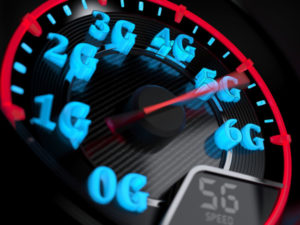 While it may still be years away, developing an understanding of how 5G will impact your enterprise will be hugely beneficial in the long run.
While it may still be years away, developing an understanding of how 5G will impact your enterprise will be hugely beneficial in the long run.
With 5G likely to debut by 2020, it is important for IT leaders to know what this generational mobile technology is all about, especially in terms of planning and strategy purposes.
You may have already heard that 5G will be 10-100x faster than 4G. This could mean real-world speeds of about 4Gbps or more. Lan Yun, president, Carrier Network Business Group, Huawei ME, says 5G will be the key to a better connected world, and will be far superior to 4G or even LTE in terms of latency and its number of connections. “5G will have a fundamental impact on the industrial transformation of ICT and human life as we know it,” he says. “As a key enabler of future digital connectivity, the technology will serve as the platform for a connected world.”
According to Rakesh Lakhani, head of Network Products Solutions, Ericsson ME, the move to 5G will a new element – the industrial Internet. “We will see new as-a-service business models based on network slicing. Network slices in the context of 5G will be like virtual networks on demand. 5G will enable more secure transactions and expand the battery life of IoT devices by 10x. All this will create opportunities for new cases that we haven’t yet dreamed of,” he says.
Network slicing divides the infrastructure into several virtual networks optimised for things such as high speed, low latency and low power consumption. Each virtual network gets its share of a pool of computing power, and if one gets overloaded, the others aren’t affected.
With the goal of 1 millisecond latency, which would require networks do some things as much as 10x faster than they do with 4G, the new generation of mobile technology offers many potential use cases, including connected cars, industrial robots and remote medicine.
Ericsson divides 5G use cases into six categories:
Broadband and media everywhere: When 5G becomes a reality, users will be able to communicate in crowded or remote areas with lightning fast broadband. Media has the power to become on-demand from any location and any device.
Smart vehicle and transport: The movement towards 5G means massive machine-type communications that will allow cities, transportation and infrastructure to transmit real-time data for improved maintenance and greater operational efficiency.
Critical services and infrastructure control: The high reliability and low latency of 5G unlocks the ability to control critical services and infrastructure. This creates new opportunities for public safety, government, city management and utility companies.
Critical control of remote devices: 5G introduces the ability to remotely control devices and heavy machinery, thus unlocking the potential for improved medical services and surgeries that would otherwise be unavailable to rural communities. 5G would also allow for heavy machinery to be controlled from a distance, making hazardous situations safer for humans.
Human and machine interaction: 5G means unlocking the potential for us to interact and connect with machines in unprecedented ways.
Sensor networks: 5G technology will expand business opportunities and business models through monitoring, tracking and automation capabilities on a large scale. From connected farms and agriculture to smart cities and buildings, 5G technology reduces costs, improves efficiency and provides real-time data in amazing new ways.
The speed boosts, low latency, and backwards compatibility with existing networks will provide a good framework for new architectures we have not seen previously, says Akshay Sharma, a research director for carrier infrastructure at Gartner.
“5G wireless will add new architectures like Cloud RAN (radio access network) where localised nano-data centres will occur, supporting server-based networking functions like industrial IoT gateways, video caching and transcoding at the edge for ultraHD video, and newer mesh-like topologies supported with more distributed HetNets (heterogeneous networks),” he says.
Industry experts point out that IT leaders should view 5G as more than just a speed boost. In fact, it is mostly related to making sure networks can handle a massive spike in the number of devices. In addition, 5G is expected to decrease the energy requirements for devices, enabling battery life up to 10 years in some cases. This will significantly reduce maintenance costs, making large IoT installations more practical and cost-effective.
Now for the bad news. Besides the lack of handsets, part of the plan for reaching very high speeds in 5G is to use frequencies far above anything ever used in cellular. There is a lot of spectrum up there, but regulators around the world first have to agree on how to assign it. That won’t happen until the next World Radio Communication Conference in 2019, putting a dampener on hopes for real 5G before 2020.
“There is a need for spectrum harmonisation between countries planning early 5G deployment,” Lakhani says. “This needs to be done in addition to the current process for WRC-19, which focuses on spectrum for commercial 5G deployment beyond 2020. Backhaul spectrum for 5G networks also needs to be considered as additional challenges exist for microwave backhaul for the evolution of 4G towards 5G. Frequency bands used for microwave vary greatly from one location to the next. This is because the most appropriate band depends on the regional climate and the national spectrum regulations, among other factors.”
Yun from Huawei adds that the major challenge today is determining how to achieve the vision of 10Gbps throughput, 1ms latency and capacity for 100 billion device connections.
“With extensive experience in 2G, 3G and 4G solutions, and now with 5G research underway, we believe the timetable set by 3GPP is a realistic one. The 5G market should therefore be ready for commercial deployment by 2020. Obviously, this is still a work in progress, as 3GPP began working on 5G from March 2016 and will continue over the next 4-5 years,” he says.
Though the much-anticipated 5G stand won’t be finished before 2020, trials are already underway from companies including Nokia and Samsung. Industry analysts say South Korea will likely have 5G running in time for the Winter Olympics in 2018. If that happens, the enterprise will be able to how those launches transpire, how users respond, monitor which devices become available to support the new standards and be mindful of any infrastructure glitches.





